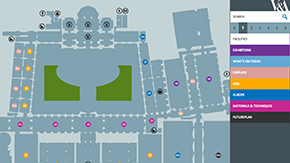Display: Musical Wonders of India
Bin Sitar
On display in South Asia, Room 41, 16 September 2015 - 31 October 2016
This is a rare hybrid instrument, unique to the Pune region. It looks like a rudra vina or bin and has the same sequence of strings, but it is smaller, and the moveable frets and flat-faced neck are like the sitar, which had become more common by the 1890s. The frets were reportedly also arranged exactly as for a sitar.

Bin-sitar, wood, gourd and wire strings, length 115.5cm, possibly Pune, India, 1850-1890. Museum no. IS.47-2002 © Victoria and Albert Museum, London.
The name bin-sitar for this hybrid instrument was recorded by Major Charles Russell Day (1860-1900), who owned this example, in his pioneering book The Music and Musical Instruments of Southern India and the Deccan (1891). The name sitar-bin (sitar-been) has also been recently proposed by several leading authorities as the most suitable, although, as Dr Allyn Miner records in her book 'Sitar and Sarod in the 18th and 19th Centuries', another type of sitar had already been given that name in Rajasthan.
For the Musical Wonders of India project, this unique instrument will be restrung and played for the first time in over a century by a musician from a family with a musical heritage stretching back over 21 generations, the maestro Ustad Bahauddin Dagar.
The neck or spine of the instrument is carved and has been hollowed out. The resonance thus comes from the hollow spine as well as from the gourds. The hollow spine is capped with a wooden piece at the bridge end but there is no joint at the end where the tuning pegs are. The flat top of the spine enables the inclusion of eighteen moveable frets. There are seven slots for major strings but only five major tuning pegs. Ten pegs have been placed along the spine for tuning sympathetic strings, which would vibrate in harmony with the major strings.
The two gourds on which the spine of the sitar-bin rests are open at the base to transmit sound. They are each decorated with lotus patterns at the top where they are connected to the spine with metal fixings. Each gourd has six prominent cartouches with images of deities.
These show avatars or forms of the Hindu god Vishnu in which he descended to earth to defeat evil, with the exception of one cartouche, which has a painted representation of the god Shiva. The gourd at the bridge end has images of the incarnations of Vishnu, who is mostly shown with blue skin, as Matsya (the fish), Kurma (the tortoise), Varaha (the boar), Narasimha (the man-lion, shown white-bodied), Vamana (the dwarf), and Parashurama, with an axe and a shield.
The gourd at the end near the tuning pegs has images of the avatars of Vishnu as Rama, Krishna (here seen killing the crane demon Bakasura), Kalki with a white horse, another avatar of Vishnu (possibly Krishna again, Balarama or the Buddha, considered by many Hindus to be a manifestation of Vishnu), Krishna lifting Mount Govardhana, and the aforementioned image of Shiva.
At the base of the gourds, above the lotus flower and between the cartouches, are motifs of flowers, fish (at the pegs end) and tortoises (bridge end).
This instrument was lent to the Royal College of Music in about 1892, along with seven others from Major Day’s collection, and then transferred to the V&A at the request of his daughter, Miss Cecilia Day, in 1921.
Supported by
![]()

Contents
Interactive Map

Discover the many treasures in the beautiful V&A galleries, find out where events are happening in the Museum or just check the location of the café, shops, lifts or toilets. Simple to use, the V&A interactive map works on all screen sizes, from your tablet or smartphone to your desktop at home.
Launch the Interactive Map




